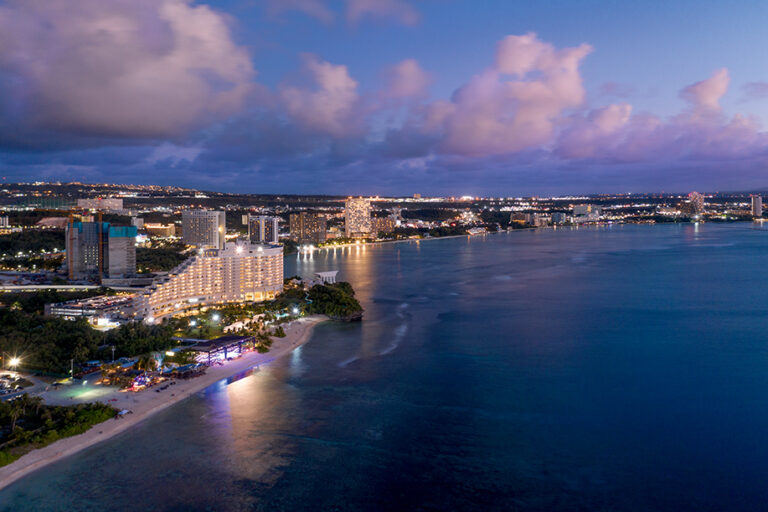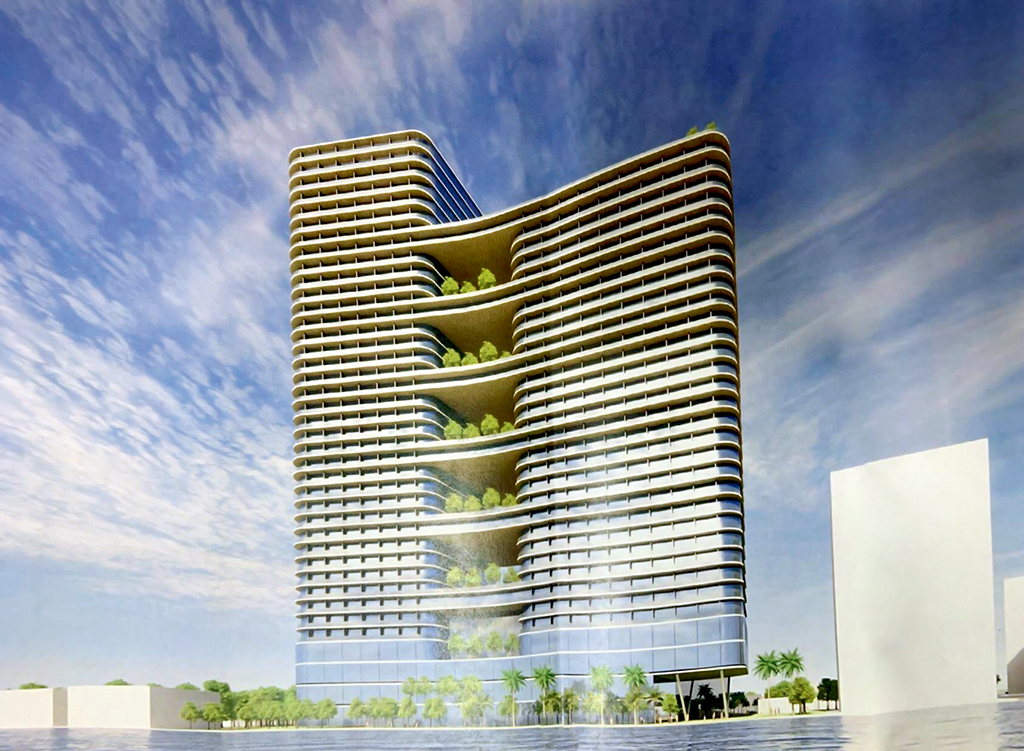Guam’s tourism sector is thrilled about a new project that will stick up in the Tumon Bay skyline.

“It will be tall—the tallest building on Guam to date,” says Brent Wiese, senior vice president and managing principal at RIM Architects Guam, which designed the $300 million hotel project proposed by Honhui Guam LLC, a subsidiary of Hongwell Group Taipei.
“The owners want to develop a high-end luxury resort hotel with large rooms and deep decks. This is intended to be a step up from the new Tsubaki Tower Hotel,” Wiese says, referring to the 340-room, 26-story luxury hotel that opened in 2020.
The Tsubaki Tower was the last hotel built on Guam since Dusit Thani Guam Resort, which opened in 2015.
Wiese says Honhui plans to entice visitors who tend to stay longer and spend more money while vacationing on Guam. “Also, the project will expand into a relatively underutilized market for Guam,” he adds.
According to its website, Hongwell, a real estate development company, specializes in developing “aesthetically pleasing but functional commercial buildings, shopping malls and hotels.”
Honhui’s project will be a welcome addition to Guam’s tourist district of Tumon as the island gears up for post-COVID-19 recovery.

An aerial view of Tumon Bay in Guam at dusk. PHOTO COURTESY: ISTOCK/ DONG WON LEE
According to Honhui’s applications for zone change, land use and zone variances, the project involves the construction of a two-tower hotel with connected landscaped walkways, a water park and a five-story parking garage.
The proposed hotel’s 37-story north tower and 31-story south tower will be built on a 7-acre beachfront property on Pale San Vitores Road in Tumon, where the earthquake-damaged and now demolished Royal Palms Hotel used to sit.
“The concept design is from a Chicago architect, with our assistance, as to how to improve property access, include local requirements, address extreme wind and seismic loads, and the harsh marine environmental effects,” Wiese says.
The two towers will be connected at every five-floor level to create a unique form. “It will have deep decks with lots of glass to take advantage of the great views. Landscaping, colors and interior finish materials will all be selected to be uniquely Guam,” Wiese says.
“[We intend this] to be the most sustainable hotel on-island. It will create a wider and more inviting public beach access, with dedicated parking spaces. It will have a memorial monument for the cultural and historical artifacts found on-site, with dedicated parking,” Wiese says.
The small apartment buildings on the project site and the abandoned parking structure, which became a haven for the homeless, have both been demolished. “Most of the trash has been removed. Finally, the homeless drug haven is gone. We apologize to the neighbors for the noise and appreciate their patience,” Wiese says.
The developer acknowledges the challenge of erecting a colossal structure on an earthquake- and typhoon-prone island. Guam is still in the initial stages of applying the 2009 International Building (IBC). Currently, the tallest building on Guam is the 32-story, 777-room Pacific Islands Club Guam, which was built in 1980.
“The owner anticipates needing 900 employees to run the facilities, so this would have a huge beneficial impact on the labor force on the island”
-Brent Wiese
Guam’s climate situation “was our first concern” when the Honhui concept was proposed, Wiese says. “We all know how strong the winds can be, and we were concerned with the open spaces between the towers.”
The project thus required a wind study. “With minor modifications, it showed that the open spaces between and around the buildings would not create wind tunnels,” Wiese says. “We worked with the owners to design the structure to the latest code standards, the 2021 IBC. This will be a safe and secure structure.”
While the cost of the project was initially estimated at $300 million, Wiese says the actual amount is still being projected. “As the design moves forward, cost estimating will be part of the process,” he says.
At this point, no company has been selected to build the structure, pending approval by the Land Use Commission.
“I have no idea how many workers it will take for construction. The owner anticipates needing 900 employees to run the facilities, so this would have a huge beneficial impact on the labor force on the island,” Wiese says.
Hotel development is among the investments that enjoy tax breaks under the Guam Economic Development Authority’s qualifying certificate program. Guam seeks to grow its hotel room inventory from 8,451 to 10,091.
The Guam Visitors Bureau’s (GVB) 2020 blueprint recommended more tax incentives for existing hotel owners to encourage them to refurbish, repair and renovate their facilities. “Hawaii’s Act 108 is one such example that provided a 4% refundable credit for these projects,” GVB said.
Besides developing the hotel design, Rim Architects is also processing the permit applications on behalf of Honhui through the Guam Department of Land Management. “There are two: one for the zone change for two lots and the other for the land use and zone variances,” Wiese says.
The zone change hearing was set for Jan. 18, and the land use and zone variances were scheduled for Jan. 19. Commencement of the project depends on the land use agency’s approval. “Once we get through land use approvals, we can start setting dates for groundbreaking and occupancy,” Wiese says.
Paul Chen, director general of the Taiwan Economic and Cultural Office on Guam, says Honhui’s proposed investment could grow bigger than the $300 million initial cost projection.
“That’s just one company, and $300 million is based on the currency exchange rate right now,” Chen says. “It will take five to six years to build the hotel. It is very likely it could cost more. It will create thousands of job opportunities.”
In perspective, Chen says the Taiwanese developer’s hotel investment may be the biggest in the region. “President Biden announced that the U.S. is investing $810 million in this region—that’s for 18 island countries,” he says. “But this company is going to invest $300 million in Guam alone.”




